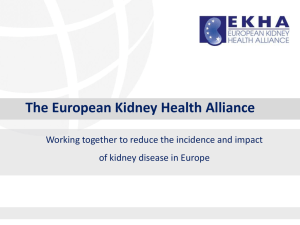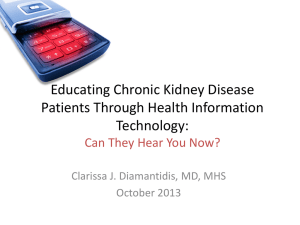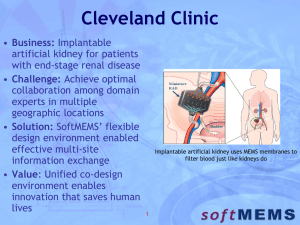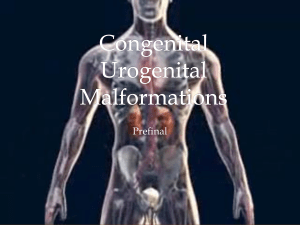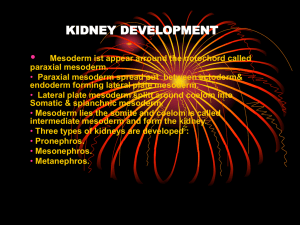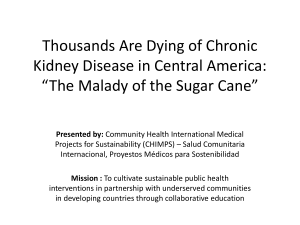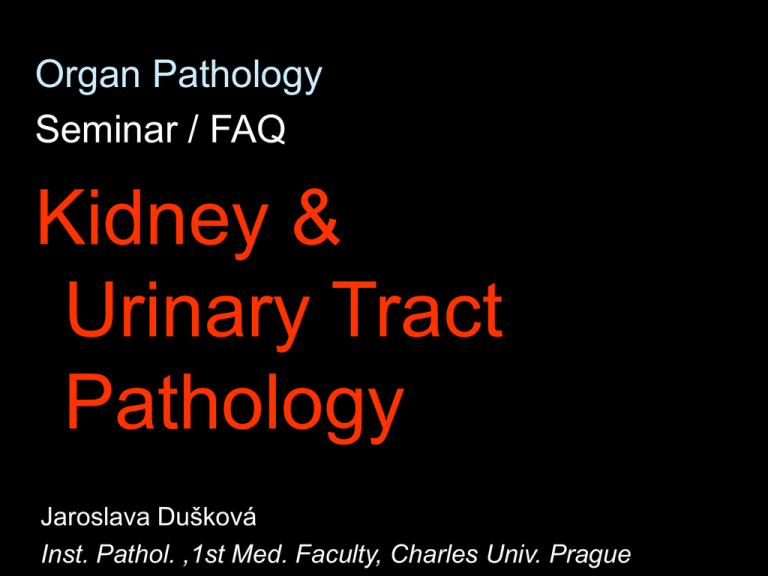
Organ Pathology
Seminar / FAQ
Kidney &
Urinary Tract
Pathology
Jaroslava Dušková
Inst. Pathol. ,1st Med. Faculty, Charles Univ. Prague
Diseases
of the kidney
and
urinary tract
Classification?
Most
frequent/important
ones ?
Disease
Nosologic Unit
Definition
Incidence
, age/sex prevalence (if any)
Etiology
Possible
clinical manifestation
Pathogenesis
– macroscopy
– microscopy
– ultrastructure or other dg. tools
– other (nonmorphological) dg. tools
Complications
Healing
& prognosis
Non-neoplastic
– inflammation
acute/chronic
specific/non-specific
superficial/intersticial
– pseudotumours
Neoplastic
–benign
–borderline
–malignant
Classification
inborn
– agenesis, hypoplasia, dysplasia, cystoses
acquired
– noneoplastic
inflamm.
+ lithiasis
pseudotumours
– NEOPLASMS
benign
MALIGNANT
Morphology features of “benign” and
malignant hypertension in kidney
Morphology features of “benign” and
malignant hypertension in kidney
„Benign“ hypertension : atherosclerosis,
fibroelastosis, hyalinized arterioles multiple
scars – granular surface
Malignant hypertension (diast. pressure over
130mmHg) -autoimmune- IB against renin –
angiotensin components. Fibrinoid necroses
of arterioles, kidney edema & hemorrhages,
necroses of kidney cortex. Death from brain
haemorrhage or heart failure if not treated
aggresively
RQ 99, 100
Vasculitides Affecting the Kidney
Systemic
AB against BM – Goodpasture –
pulmorenal syndrome
Vasculitides with immune complexes – HenochSchönlein, SLE,
ANCA –positive
– Wegener´s granulomatosis
– microscopic polyangiitis
– Churg- Strauss syndrome with eosinophilia and
astma
Kidney morphology : necrotizing pauciimmune
GN with crescents
RQ 101
Glomerulonephritis/Glomerulopathy
Glomerulonephritis/Glomerulopathy
primary (inborn, acquired) – secondary
(following or accompanying another
disease like SLE, hepatitis C etc.)
Manifesting clinically as:
– proteinuria-nefrotic syndrome
– hematuria prevalent
– combined (h+p)-uria
– GN in vasculitides
– GN in SLE
– chronic GN
Glomerulonephritis
special group of inflamm. glomerular
diseases caused by:
– depositon of immune complexes
– antibodies against glomerular
components
– antibodies against glomerular depositions
– ANCA – anti-neutrophil-cytoplasmantibodies
Glomerulonephritis – clinic
– nephritic syndrome
hypertension
hematuria
mild proteinuria
oedema
– nephrotic syndrome
massive proteinuria
hypalbuminemia
oedema
hypercholesterolemia
Terminal stage of kidney failure
UREMIA
Glomerulonephritis - morphology
Macroscopy:
early:
mild enlargement, petechiae,
late:
end stage kidney
Microscopy:
glomerular changes & scaring
Diagnosis:
clinical symptoms,
punction biopsy
immunohistochemistry and electron microscopy
Glomerulopathies manifesting
with acute nephritic syndrome
Acute postinfectious (strepto and
others, SLE…)
Kidney morphology : GN with increased
cellularity (mesangial and endocapillary)
Membranoproliferative – secondary to
hepatitis B, C, HIV, SLE,
neoplasms….
RQ 105
Glomerulopathies with hematuria
Clinic: hematuria - diff. dg!!!.
Progression to failure
IgA nephropathy
– Kidney morphology : mesaingioproliferative
GN with IgA deposits
Henoch
Schönlein
Alport syndrome – mutation of colagen IV gene
RQ 105
Rapidly Progressive GN
Clinic: hematuria, proteinuria, loss of kidney function
Kidney morphology : GN with crescents
Etiology - variable:
– ANCA –positive
Wegener´s granulomatosis
microscopic polyangiitis
Churg- Strauss syndrome with eosinophilia and astma
– anti GBM GN
– Vasculitides with immune complexes – HenochSchönlein, SLE,
– idiopatic…(= unknown)
RQ 103
Glomerulopathies with nephrotic
syndrome
Clinic: proteinuria
Minimal change disease (in children ) – fusion
of pedicels, response to steroid th.
NSAID related GN in adults
Focal Segmental GlomeruloSclerosis: heroin,
secondary to gl.-loss nephropathy
Amyloid
Diabetic GN
RQ 104
SLE and its Kidney
manifestations
Multisystem
autoimmune disease with rash,
artralgiae, oral ulcers, RENAL
DISORDERS… Libman –Sacks endocarditis,
CNS dmage…..
Antinuclear and other antibodies
6 classes of kidney involvement (minim,
mesangial, focal, diffuse, membranous,
advanced) – difference in therapy and
prognosis
RQ 106
Diseases of Kidney Tubules and
Intersticium
Acute tubular necrosis ATN ( drugs - atb,
toxins – heavy metals, - shock kidney
– oliguria <400ml - anuria < 100ml - subsequently polyuria
>3000ml in 24 hours
Tubulointersticial nefritis
viruses, metabolic disorders)
TIN (bacteria,
Drug
induced – NSAID,
Light
chain deposition disease
analgetic – phenacetin
RQ 98
Ascendent kidney infections
Ascendent kidney infections
tubulointerstitial nephritis –
pyelonephritis
mostly G- bacteries
risk increased in
– diabetics,
– pregnant,
– lithiasis
complications:
– urosepsis
– amyloid
Pathology of gonorrhoea
Man
Woman
urethritis gonorrhoica
endocervicitis
anterior
colpitis ulcerosa
urethritis gonorrhoica
endometritis
posterior – strictura partis salpingitis purulenta
membranaceaa urethrae
pelvic inflamm. tumour
balanitis erosiva (esp. in
phimosis)
prostatitis abscedens
Newborn
vesiculitis seminalis
purulenta
vulvovaginitis
hydrocele acuta
conjunctivitis
Systemic Effects of Uremia – 1/2
skeletal
– osteitis fibrosa
– demineralization and fibrosis – osteomalacia
(rickets), pain, spontaneous fractures
cardiopulmonary
& blood
– hypertension, normochromic and normocytic
anemia, edema, pericarditis – friction rub
GIT
– anorexia, nausea, mouth ulcers, stomatitis,
peptic ulcers, colitis, bleeding, hiccups
Systemic Effects of Uremia – 2/2
NEUROLOGIC
– ENCEPHALOPATHY
– fatigue, loss of attention, problém solving
difficulties, motor coordination, twitching,
stupor , coma
Integumentary
& immunologic
– abnormal pigmentation and pruritus
– increased risk of infection and neoplasms
Reproductive
– menorrhagia, amenorrhea,
– infertility, loss of libido – both sexes affected
Kidney Transplantation and
Rejection Morphology
Rejection – result of MAJOR HC and minor HC
glycoproteins and peptides
T and B lymhocytes activity
Acute cellular: (Banff criteria)
– mild – intersticium and tubules damage
– severe – arterial damage
Acute humoral (early and late – years): Donor
Specific Antibodies
Chronic: intersticial fibrosis , vascular damage
Graft damage of non- rejection type: infection – viruses
–CMV, drugs, preceding diseases – diabetes….
RQ 107
Kidney Neoplasms ?
classification principles
clinical manifestation
most frequent representatives
complications
Kidney Neoplasms
benign - mixed mesench., adenoma, papiloma
MALIGNANT – ADENOCARCINOMA,
UROTHELIAL CARCINOMA
Complications : anemia, polyglobulia, METASTASES,
Kidney Tumours - mesenchymal
Angiomyolipoma - mixed
mesenchymal tumour
ICD-O M 8860/0
sporadic or associated with tuberous
sclerosis (TSC 1,2 genes – 9q34)
occasionally large & multiple, bulging
Papillary (Chromophillic) Ca
M 8260/3
10%
In dialysed more frequent; can be multifocal and
bilateral
X-ray hypovascular
Histology – papillary/ tubulopapillary
type 1 – cubic cells
type 2 - cylindric cells (worse prognosis)
Genetics – trisomy or tetrasomy 7 and 17
in men often Y chromosome missing
mutation of c-met oncogen
Prognosis : G, pT dependent
slightly better than in conventional ca
Chromophobe Carcinoma
M 8317/3
Macro
Mikro
5%
- brown color
- solid, cytoplasms clear or eosinophillic
Elmi
Genetics
positive in Hale´s colloidal iron staining
raisin-like cell nuclei
microvesicles in cytoplasm
missing chromosomes 1, 2, 10, 13, 6, 21, 17
Prognosis: G, pT dependent
Oncocytoma
M8290/0
Kidney cortex
may be multicentric and bilateral
Macro – tan with a central stellate scar
Micro - eosinophillic granular cytoplasm
bizarre nuclei
Elmi
– mitochondria filling up the cytoplasm
Biological behaviour
benign
Nephroblastoma (Wilms´tumour)
M 8960/3
syn. - embryonal adenosarcoma
Children - preschool age
Macro: gray-white large retroperitoneal
mass palpable through abdominal wall
Micro: undifferentiated renal blastema,
tubular and glomeruloid formations may
be present
Prognosis: curable (stage!) – resection
and chemotherapy
Follow up: - nephrogenic rests
Nephroblastoma (Wilms´tumour)
M 8960/3
Genetics
WAGR syndrome – Wilms-Aniridia-Genital
Anomaly-Retardation
Denys – Drash syndrome DDS - gonadal
dysgenesis and renal abnormalities
inactivation of the WT 1 gene
Beckwith –Wiedeman syndrome BWS organomegaly ( tongue, kidney, liver,
hemihypertrophy)
loss of silencing of maternal IGF 2 gene
Kidney Carcinoma – report
type
grade (Fuhrmann)
stage
prognostic factors (MIB1, p53…)
Urothelial Neoplasms ?
Urothelial Neoplasms
papiloma
(rare)
urothelial papilocarcinoma
incidence growing
Symptoms
– hematuria
– anemia
macroscopic
microscopic
– obstruction – ureteri and pelvis
Urothelial Carcinoma – report
type
grade
resection completeness
stage
prognostic factors (MIB1, p53…)
Urothelial Carcinoma complications
local recurrence
progression
metastases

